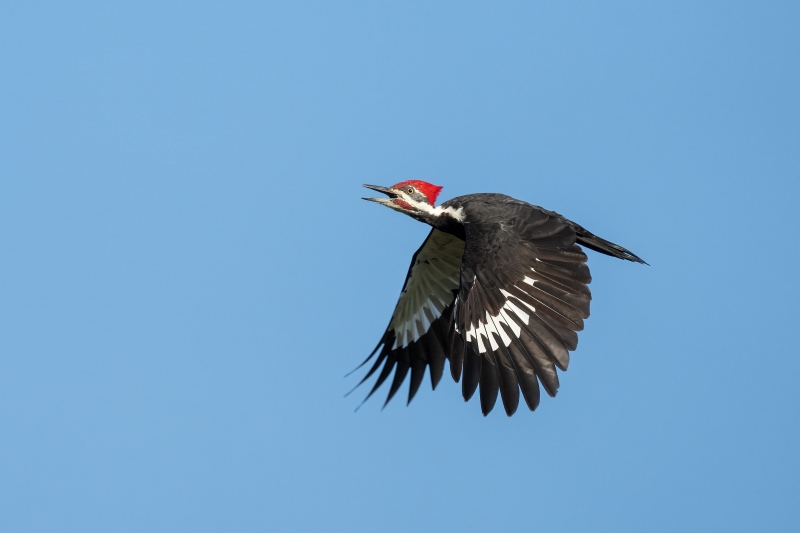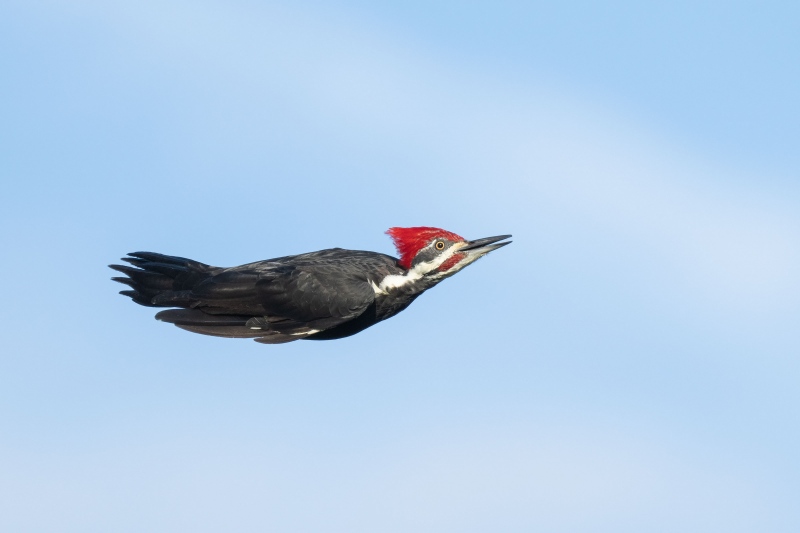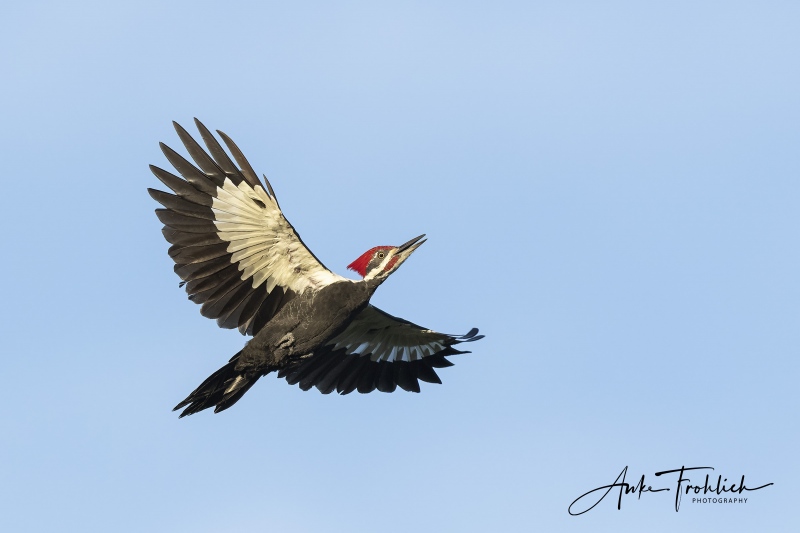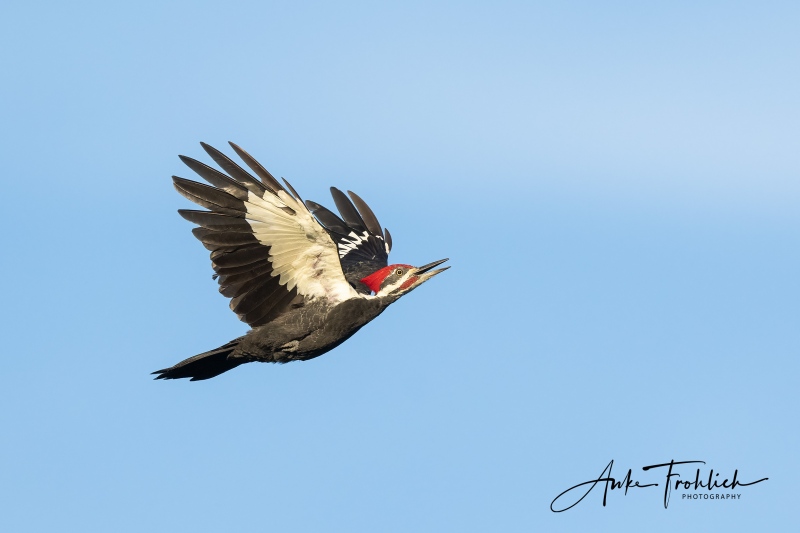Creating Today’s Featured Images
The first two images in today’s blog post were created by yours truly on September 26. The last two images were created by Anke Frohlich (in virtually the same instant) on September 27. The funny thing is that on Sunday, while using the 200-600, I got several really good images while Anke, using the hand held 600mm f/4, struck out. The next day, with each of us using the 600mm f/4s, I got nothing and Anke absolutely kicked my butt.
If you would like to learn exactly how we had so many good chances to photograph Pileated Woodpeckers in flight, shoot me a PayPal for $20.00 to birdsasart@verizon.net with the words Pileated Flight Photography Trick included in the e-mail. This trick works well with many bird families. The odds are that it will help you get some great images of typically difficult-to-photograph species.
Your Fave?
Which of the four flight poses is your favorite? All are invited to leave a comment and let us know why they made their choice.
What’s Up?
I spent a good part of the last two days working on the pre-trip info letters for the 2nd and third Fort DeSoto IPTs and the sold out Homer Bald Eagle IPT. Today is Friday 1 October. Wherever you are, and whatever you are doing, I hope that you too have a great day. This blog post more than two hours to prepare including the time spent on the four image optimizations.
If you missed the Bird Photography Heaven at Fort DeSoto with Arthur Morris/BIRDS AS ART video, you can view it here.
Remember that you can find some great photo accessories (and necessities, like surf booties!) on Amazon by clicking on the Stuff tab on the orange/yellow menu bar above. On a related note, it would be extremely helpful if blog-folks who, like me, spend too much money on Amazon, would get in the habit of clicking on the Amazon logo link on the right side of each blog post when they shop online. As you might expect, doing so will not cost you a single penny, but would be appreciated tremendously by yours truly. And doing so works seamlessly with your Amazon Prime account.
Please remember that if an item — a Delkin flash card, or a tripod head — for example, that is available from B&H and/or Bedfords, is also available in the BAA Online Store, it would be great, and greatly appreciated, if you would opt to purchase from us. We will match any price. Please remember also to use my B&H affiliate links or to save 3% at Bedfords by using the BIRDSASART discount code at checkout for your major gear purchases. Doing either often earns you free guides and/or discounts. And always earns my great appreciation.
|
Fort DeSoto in fall is rife with tame birds. All of the images on this card were created at Fort DeSoto in either late September or very early October. I hope that you can join me there this fall. Click on the composite to enjoy a larger version. Clockwise from upper left to center: Long-billed Curlew, Marbled Godwit, Caspian Tern, Great Egret, Sandwich Tern with fish, Willet, Black-bellied Plover threat display, Snowy Egret, 2-year old Yellow-Crowned Night-Heron, juvenile Yellow-Crowned Night-Heron. |
The Fall 2021 Fort DeSoto Instructional Photo-Tours
Fall 2021 Fort DeSoto Instructional Photo-Tour #2
3 1/2 Days: Tuesday 5 October through the morning session on Friday 8 October. $1999.00 includes three working lunches. Limit six photographers/Openings 3.
Fall 2021 Fort DeSoto Instructional Photo-Tour #3
3 1/2 Days: Tuesday 19 October through the morning session on Friday 22 October. $1999.00 includes three working lunches. Limit six photographers/Openings 3.
Fort DeSoto in Fall
Fort DeSoto, located just south of St. Petersburg, FL, is a mecca for migrant shorebirds and terns in fall. There they join hundreds of egrets, herons, night-herons, and gulls that winter on the T-shaped peninsula. With any luck at all, we should get to photograph one of Florida’s most desirable shorebird species: Marbled Godwit. Black-bellied Plover and Willet are easy, American Oystercatcher is pretty much guaranteed. Great Egret, Snowy Egret, Great Blue Heron, Tricolored Heron, and White Ibis are easy as well and we will almost surely come up with a tame Yellow-crowned Night-Heron or two. And we will get to do some Brown Pelican flight photography. In addition, Royal, Sandwich, Forster’s, and Caspian Terns will likely provide us with some good flight opportunities as well. Though not guaranteed, Roseate Spoonbill and Wood Stork might well be expected. And we will be on the lookout for a migrant passerine fallout in the event of a thunderstorm or two.
On this IPT, all will learn the basics and fine points of digital exposure. Nikon and Canon folks will learn to get the right exposure every time after making a single test exposure, and SONY folks will learn to use Zebras so that they can be sure of making excellent exposures before pressing the shutter button.. Everyone will learn how to approach free and wild birds without disturbing them, to understand and predict bird behavior, to identify many species of shorebirds, to spot the good situations, to choose the best perspective, to see and understand the light, and to design pleasing images by mastering your camera’s AF system. Most importantly, you will surely learn to evaluate wind and sky conditions and understand how they affect bird photography. And you will learn how and why to work in Manual mode (even if you’re scared of it). The best news is that you will be able to take everything you learn home with you so that you will be a better photographer wherever and whenever you photograph.
There will be a Photoshop/image review session during or after lunch (included) each full day. That will be followed by Instructor Nap Time.
These IPTs will run with only a single registrant (though that is not likely to happen). The best airport is Tampa (TPA). Once you register, you will receive an e-mail with Gulfport AirBnB information.
A $500 deposit is due when you sign up and is payable by credit card. Balances must be paid by check after you register. Your deposit is non-refundable unless the IPT sells out with six folks, so please check your plans carefully before committing. You can register by calling Jim or Jennifer during weekday business hours at 863-692-0906 with a credit card in hand, or by sending a check as follows: make the check out to: BIRDS AS ART and send it via US mail here: BIRDS AS ART, PO BOX 7245, Indian Lake Estates, FL 33855. You will receive a confirmation e-mail with detailed instructions, clothing, and gear advice. Please shoot me an e-mail if you plan to register or if you have any questions.
|
Clockwise from upper left to center: Long-billed Curlew, juvenile Tricolored Heron, Marbled Godwits, Great Blue Heron, juvenile Pectoral Sandpiper, Wood Stork, smiling Sea Scallop, Ruddy Turnstone scavenging needlefish, Great Blue Heron sunset silhouette at my secret spot, and southbound migrant tern flock blur. |
Up Early, Stay Out Late!
Obviously folks attending an IPT will be out in the field early and stay late to take advantage of the sweetest light and sunrise and sunset colors (when possible). The good news is that the days are relatively short in early fall. I really love it when I am leaving the beach on a sunny morning after a great session just as a carful or two of well-rested photographers are arriving. The length of cloudy morning sessions will often be extended. Click on the composite to enjoy a larger version.
|
|
|
I created this image on 26 September 2021. I used the hand held Sony FE 200-600mm f/5.6-6.3 G OSS lens (at 600mm) and The One, the Sony Alpha 1 Mirrorless digital camera. ISO 1250. Exposure determined via Zebras with ISO on the rear dial: 1/3200 sec. at f/6.3 (wide open) in Manual mode. RawDigger showed that the raw file brightness was perfect. AWB at 8:34am on then-cloudy morning. Center Zone/AF-C Bird/Eye Detection AF was active at the moment exposure and performed perfectly by nailing the bird’s left eye. Click on the image to view a hi-res version. Image #1: Pileated Woodpecker full downstroke
|
The Wings-down Flight Pose
Flight images that feature both wings in the fully down position — as with Image #1 above, often work very well. On both days, each of us deleted dozens of sharp flight shots because the birds — they were a pair, were angling slightly aways from us. With all of our best images, the birds were angling slightly toward us.
|
|
|
I created this image on 26 September 2021. I used the hand held Sony FE 200-600mm f/5.6-6.3 G OSS lens (at 600mm) and The One, the Sony Alpha 1 Mirrorless digital camera. ISO 1250. Exposure determined via Zebras with ISO on the rear dial: 1/3200 sec. at f/6.3 (wide open) in Manual mode. RawDigger showed that the raw file brightness was perfect. AWB at 8:36am on then-cloudy morning. Center Zone/AF-C Bird/Eye Detection AF was active at the moment exposure and performed perfectly by nailing the bird’s left eye. Click on the image to view a hi-res version. Image #2: Pileated Woodpecker, bullet flight pose
|
The Bullet Flight Pose
I am not sure that I have seen photographs of any birds but woodpeckers in this seemingly strange flight pose with the wings tightly tucked against the bird’s body. Have you? Photography often allows us to see things that we simply miss with the human eye. And the SONY a1’s 30 frames per second is a champion at doing just that.
|
|
|
This image was created on 27 September by Anke Frohlich. While standing, she used the hand held Sony FE 600mm f/4 GM OSS lens and The One, the Sony Alpha 1 Mirrorless digital camera. ISO 2000. Exposure determined via Zebras with ISO on the rear dial: 1/4000 sec. at f/5.6 (stopped down one stop) in manual mode. RawDigger showed that the raw file brightness was perfect. AWB at 7:55am on a windy very cloudy stormy morning. Zone/AF-C was active at the moment of exposure and performed perfectly. Be sure to click on the image to enjoy the larger version. Image #3: Pileated Woodpecker, flying up to perch |
The Crops
Today’s four featured images on average represent only about 33% of the original pixels with about 66% cropped away and discarded. Anke loves shooting wide, cropping, and taking advantage of the superb image quality of sharp a1 raw files. A further advantage of shooting flight and action small-in-the frame is that you will often have more than enough depth-of-field to cover a singe bird, and with a bit of luck, to cover two subjects that are interacting.
|
|
|
This image was created on 27 September a fraction of a second later than Image #3 by Anke Frohlich. While standing, she used the hand held Sony FE 600mm f/4 GM OSS lens and The One, the Sony Alpha 1 Mirrorless digital camera. ISO 2000. Exposure determined via Zebras with ISO on the rear dial: 1/4000 sec. at f/5.6 (stopped down one stop) in manual mode. RawDigger showed that the raw file brightness was perfect. AWB at 7:55am on a windy very cloudy stormy morning. Zone/AF-C was active at the moment of exposure and performed perfectly. Be sure to click on the image to enjoy the larger version. Image #4: Pileated Woodpecker, nearing perch |
The Wings-Up Flight Pose
As with the wings-fully-down flight pose, the wings-up flight pose is often a winner. This is about as “up” as a woodpecker’s wing get in flight. Again, we see the great advantage of working at 30 fps.
Typos
With all blog posts, feel free to e-mail or to leave a comment regarding any typos or errors.




















Image no.3, although it appears that part of the birds head/neck is missing. A processing error I’m guessing?
Thanks, Andy. I am not seeing anything like what you are seeing. Aside from the crop, all of the images are accurate representations of the raw files … Therefore, there are no processing errors.
with love, artie
You are of course correct, apologies, I shouldn’t look at images half asleep.
🙂 No worries. Much love, a
I love all four, but will choose number two, torpedo woodpecker.
The white balance looks to be a bit different on images 1&2 vs 3&4. Is this a processing difference? Something different based on the earlier light in photos 3&4? The first two appear bluer, the last two a bit yellower.
Thanks, Ryan,
I processed all four images without changing the WB. That said, Anke’s images, the last two, were made the day after I made my images. So it would not be unexpected that the quality of the light was a bit different. Both of our a1 bodies are set up identically with AWB.
with love, artie
I love the pileateds and their fly, glide/dip, fly pattern. That said, the bullet pose is far and away my favorite as it captures, for me, the most interesting part of their flight pattern.
#2 is dramatic, but #4 gets my vote because it exposes the white feather pattern on both the underside and top.
No. 3 for me. I like the wing position, colors and the bird position in the frame.
I like #3
I liked all 4 photos! Especially number 1 where he is yelling something –HaHaHa!!
#4 for me. tight shot, good angle and natural looking…
#2 for me : better eye contact, almost same level with the bird and unusual pose for the bird
I prefer #3. Full wing exposure.
I prefer last one. Full wing exposure.